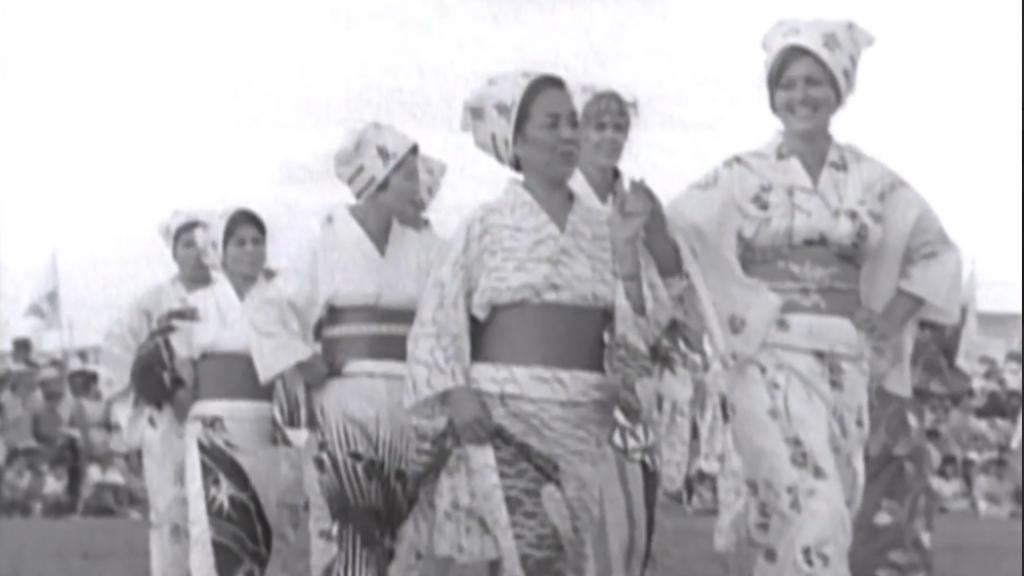- Program
- /
- Film Series
- /
- No terra nullius
- /
- Okinawa Reversion Day
Okinawa Reversion Day
Curated by Thaís Omine and Hiromi Toma
With an introduction by Thaís Omine, accompanied by an audiovisual installation by Hiromi Toma and Naomi Asato, and followed by an traditional Ryukyuan dance performance by Riko Sugama and Igor Shin
Mud Man
Chikako Yamashiro, Japan 2017, 26 min. Uchinaaguchi, Jeju with English subtitles, digital
沖縄エロス外伝 モトシンカカランヌー (MOTOSHINKAKARANNU)
Nihon Documentarist Union, Japan 1971, 84 min. Japanese and Uchinaaguchi with English subtitles, digital
Who has the right to decide what, when and how a territory and its human and non-human inhabitants are returned? Why was it taken in the first place? Which bodies are subject to negotiation, sale, trafficking, violence and alienation?
Okinawa (Former Kingdom of Ryukyu), a group of islands to the south of Japan's largest archipelago, was colonised and annexed by the Japanese Empire in 1879. During the Second World War, the territory experienced the bloodiest military confrontation between Japan and the United States, killing a third of the civilian population and leaving its survivors in a state of devastation. From 1945 to 1972, as a strategic military point for US imperialist ambitions in East Asia and the Pacific, Okinawa was designated a United States territory. On May 15th 1972, Okinawa was "returned" to Japan and incorporated into its geographical domain. Around 70% of US military bases in Asia are located on Okinawa despite widespread dissent.
Reversion Day is therefore a day to remember, reflect and fight for the right to a dignified existence of the native peoples of the Ryukyu Islands over and above imperialist and colonizing interests.
The evening will begin with a mesmerising artistic performance by Riko Sugama, a traditional dancer from Ryukyu, which will be combined with a projection of an animation by Igor Shin, followed by a double screening: Mud Man by acclaimed Okinawan visual artist Chikako Yamashiro which is set in Ryukyu and Jeju (South Korea), both territories controversially occupied by the US army, and MOTOSHINKAKARANNU (Ryukyu for "business without seed money"), a rare feature film by the iconic Nihon Documentary Union, a collective of radical left-wing filmmakers committed to breaking with traditional modes of filmmaking. Filmed in Okinawa amidst the social unrest surrounding reversion, it is composed of footage about the ongoing US military presence and conversations with sex workers, gang members and tourists.
Meanwhile, the foyer will host an audiovisual installation by Okinawan-Brazilian artist-researchers Hiromi Toma and Naomi Asato that features reflections from survivors of the Battle of Okinawa now living in Brazil, home to the largest Okinawan diaspora. (TO)
Riko Sugama is a traditional dancer from the Ryukyu Islands whose dance performances beautifully showcase the unique traditions and customs of the region.
Igor Shin is an animation artist who has studied São Paulo, Okinawa, and Cologne. In 2016, he co-founded VAMOS-Animation.
NDU. Active from 1968 to 1973, the NDU was a collective of radical leftist filmmakers, an offshoot of the intense youth activism in Japan at the time. The group was so committed to breaking traditional modes of film production and forming non-hierarchal structures that they eschewed individualism almost entirely — everyone who was a part of it was anonymous and uncredited in their work. The NDU’s population ranged from several dozen to hundreds of members over the course of its brief but fruitful lifetime. (text by Dan Schindel, from Hyperallergic)
Hiromi Toma. Uchinaanchu-Brazilian. Graduated in Accounting at FEA-USP and Fashion at Senac. Her main work is as Hajichiaa, tattoo artist and independent researcher of Hajichi - ancestral tattoo of Okinawan women (tattooed more than 120 women in São Paulo, Brasília, Campo Grande, Toronto, Vancouver, Seattle and Los Angeles). Founder of the Hajichiaa collective. Costume designer at Núcleo Lúcia Kakazu. She creates as a gesture of prayer to her ancestors. She has recently been investigating the sweat in her hands (for having hyperhidrosis) in the ŪTŌTU series as a symptom of the issues that cross generations (colonization, imperialism, stereotypes, silencing). In the rubbing of the hands in a gesture of prayer of the yutás (Okinawanas shamans), they cry the ghosts of the past, leaving in evidence traces and scars of unspoken words and gestures not carried out by the impositions and prohibitions on the bodies of their ancestors.
Naomi Asato, a Brazilian uchinanchu from the Ryukyu Minyo Hozonkai Filial Brasil sanshin group and the Olga Benario Women's Movement, both in São Paulo. She is currently studying Social Sciences at the University of São Paulo (USP).
